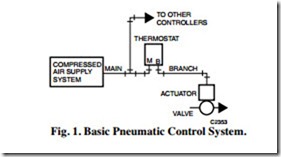BASIC PNEUMATIC CONTROL SYSTEM
GENERAL
A pneumatic control system is made up of the following elements:
— Compressed air supply system
— Main line distribution system
— Branch lines
— Sensors
— Controllers
— Actuators
— Final control elements (e.g., valves, dampers)
A basic pneumatic control system consists of an air supply, a controller such as a thermostat, and an actuator positioning a valve or damper (Fig. 1).
The controller receives air from the main line and regulates its output pressure (branchline pressure) as a function of the temperature, pressure, humidity, or other variable. The branchline pressure from the controller can vary from zero to full mainline pressure. The regulated branchline pressure energizes the actuator, which then assumes a position proportional to the branchline pressure applied. The actuator usually goes through its full stroke as the branchline pressure changes from 3 psi to 13 psi. Other pressure ranges are available.
In a typical control system, the final control element (a valve or a damper) is selected first because it must produce the desired control results. For example, a system designed to control the flow of water through a coil requires a control valve. The type of valve, however, depends on whether the water is intended for heating or cooling, the water pressure, and the control and flow characteristics required. An actuator is then selected to operate the final control element. A controller and relays complete the system. When all control systems for a building are designed, the air supply system can be sized and designed.
